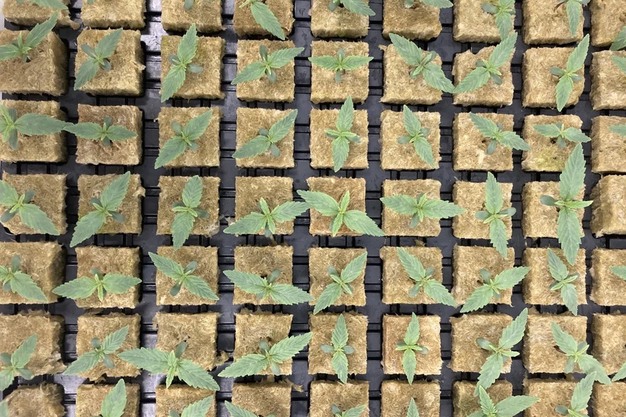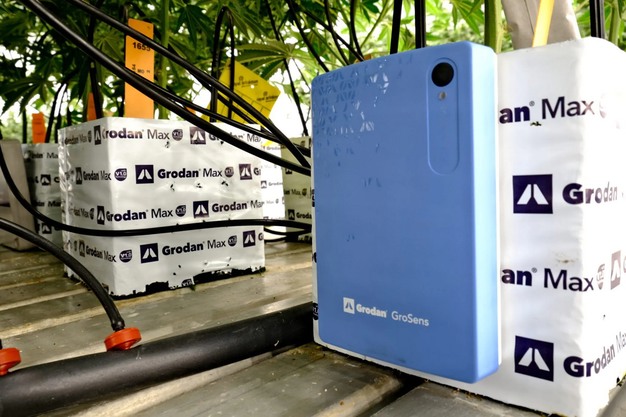"Our main goal is to develop an optimal irrigation strategy under greenhouse conditions for cannabis, to steer the plant in a generative or vegetative way." The Cultivation for Compounds (CfC) consortium contacted Frank Janssen from Grodan to tell them more about Grodan's solutions and why they joined the CfC consortium.
Frank has been working for 17 years as a Product Development Manager within the Application and Development department of Grodan. As the job title implies, he is involved with the development of the stone wool growing media for both cannabis and commercial vegetable growers. Grodan's cannabis-based research programs were a key driver in extending this program by becoming a partner within the CfC consortium.
Why has Grodan been interested in research? "In cannabis, we see a large gap in the available knowledge compared with other crops grown in Controlled Environment Agriculture (CEA) systems, such as greenhouse vegetables. Here, we have conducted research for more than 40 years. This has resulted in increased efficiencies of production through evolving production techniques, which has benefited the whole sector. In general, the cannabis sector we know and work in today is a much younger industry. Closing the knowledge gap via implementation of a structured research program is important to enable Grodan to serve our customers in the best way possible," Frank shared.
The CfC asked Frank what the reasons were for joining a long-term consortium, to which three reasons were provided.
"The opportunity to partner with companies from the whole value chain for research, from the beginning of propagation and cultivation to the end, post-harvest technologies. This is unique and allows the research questions to extend beyond the agronomic production techniques, which is often the endpoint of private research programs. These are valuable insights. Together, we get the chance to learn and gain knowledge and innovative insights about cannabis production and how growers can benefit from this."
Frank continued, "Moreover, the marketing activities that enable the knowledge transfer, the cannabis pavilion at World Horti Center (WHC), the CfC technical events that the partners co-organize, and articles such as this one help create awareness of our activities and research. The 360˚ video presented in the cannabis pavilion at WHC is an excellent piece of work. It outlines the use of cannabis over the past millennia to the present day. It tackles political issues and shows us where we are in the present day. These are some of the ways we use to shed light on this important research program. In doing so, we demonstrate how suppliers like the ones in this consortium can do intensive cannabis research and be transparent about the process and the results."
Franks also discussed the concept of root zone management and what Grodan's main goals in the research trials are. Frank elaborated, "Our main goal is to develop an optimal irrigation strategy under greenhouse conditions for cannabis, to steer the plant in a generative or vegetative way. Therefore, we are investigating and re-defining what are the optimal water and nutrient levels during each different cultivation stage of crop growth during cultivation. Our root zone sensors enable us to visualize the results of our actions." Frank adds, "All the data collected by the sensors is sent into a software platform called e-Gro, where we can follow everything that is happening in the greenhouse at any time. At the end of the day, the main goal is to be able to show that it is possible to achieve a year-round cannabis production in a greenhouse, with excellent quality, free-of-disease crop, and uniform end product. Consistency is the key factor for cannabis growers."
The CfC asked for further insights into the sensors, their role in the CfC research, and, in general, in cannabis cultivation facilities. "GroSens sensors can be used to effectively manage irrigation in the root zone. This allows the growers to closely monitor and control the irrigation process, including factors such as the growing media, Water Content, EC, and temperature. Proper root zone management is crucial for ensuring the healthy growth and development of the cannabis plants. Moreover, the infrastructure of a cannabis facility is completely different than in, for example, a vegetable greenhouse; we typically see that in cannabis, there will be more intensive use of sensors. That is mainly because, in cannabis cultivation, there are often multiple cultivars grown in several smaller compartments or grow rooms. As one can imagine, the variation at the cannabis cultivation facility, with the huge differences in growth between the cultivars, will require much more sensors than tomato, for example."
Frank summarized, "The development of these sensors and software will allow Grodan to provide their clients with better advice about root zone management, but not only. Grodan also developed climate sensors. The combination of these is what would allow us to give tailored advice and guidelines to the customers. After all the trials conducted and our experience with the growers, we created the 5-phase model that describes the irrigation management during one cultivation cycle."
To conclude, the CfC asked Frank what would happen at the end of the 4-years long consortium. "By the end of CfC, I hope we can have a blueprint to show that it is possible to cultivate in a greenhouse a consistent and high-quality cannabis crop with maximum output and minimal use of the input and resources, producing good quality sustainably and economically. The steps toward this goal can be divided by the upcoming years of the consortium. The aims of the first trials were really to learn the facility and its limitations and how we should work together in this consortium. I always say it is a 10 or 12-week sprint with a cannabis cultivation cycle, and you cannot miss a day. Now, we are making some improvements to the cultivation system and adapting based on our results until now. In the third year, we aim to achieve annual high-quality produce, and once it is achieved, we can look in the last year into whether it is possible to minimize the input, for instance, using less energy, water, and/or nutrients while maintaining high-quality crop and produce."
For more information:
Grodan
www.grodan.com
Cultivators![]()
www.cultivators.nl
